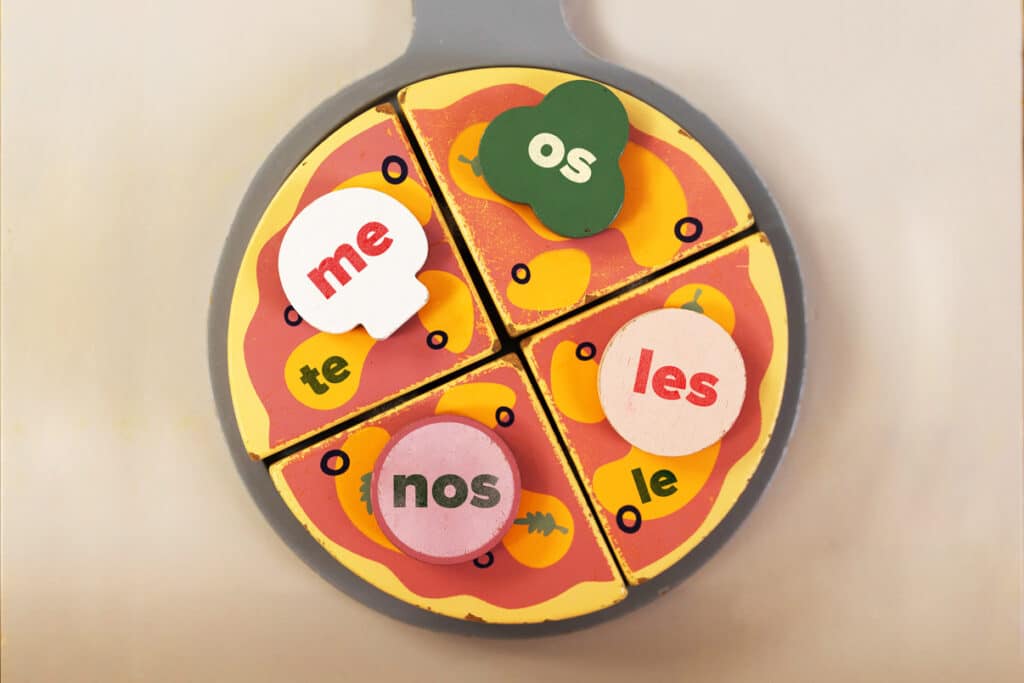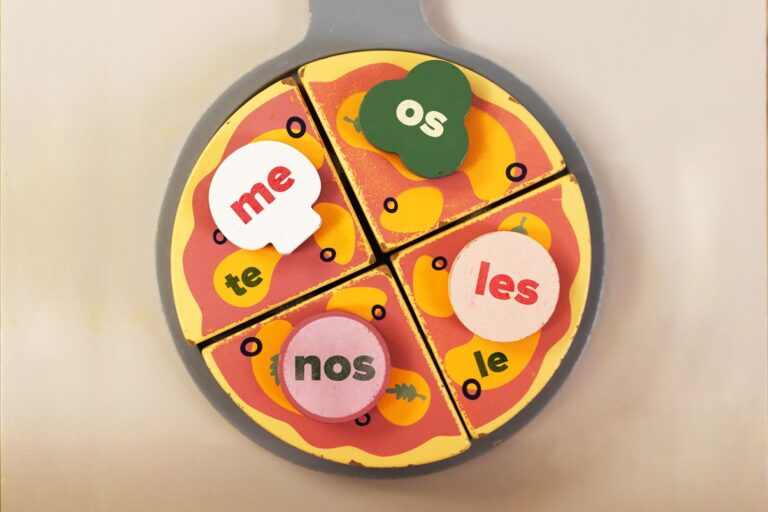
Indirect object pronouns help make our speech more fluent and easier to understand.
If your goal is to speak naturally, you’ll need to master these little words.
In this post, you’ll learn the six indirect object pronouns, their meanings and how to use them.
Contents
Download:
This blog post is available as a convenient and portable PDF that you
can take anywhere.
Click here to get a copy. (Download)
What Are Indirect Object Pronouns?
Spanish pronouns replace nouns. For example, you can change this sentence:
“I ate the pizza.” to “I ate it.”
In Spanish, there are two main types of pronouns: direct object pronouns and indirect object pronouns.
Indirect object pronouns answer the questions “to whom” and “for whom.”
Take this sentence for example:
“I bought pizza for my family.”
The pizza is the direct object, because it’s what you bought. But your family is the indirect object because they’re affected by the action and receiving the object.
So in English, using an object pronoun would change the sentence to “I bought pizza for them.”
What’s the Difference Between a Direct and an Indirect Object?
A direct object pronoun receives the action of the verb directly, whereas the indirect object pronoun is affected by the action and receives the object.
If you say “I am buying pizza for my family,” you aren’t buying your family. You’re buying a pizza.
Since your family is receiving the object (the pizza), this makes them the indirect object.
The 6 Spanish Indirect Object Pronouns
Now that you know what indirect object pronouns do, it’s time you learn what they are.
There are six indirect object pronouns in Spanish:
| Indirect Object Pronouns | |
|---|---|
| me (me) | nos (us) |
| te (you) | os (you all) |
| le (him, her, it, you formal) | les (them, you all formal) |
If you’ve already learned the direct object pronouns, you might’ve recognized that these are identical, except for the third-person singular and plural.
Spanish Verbs That Always Require Indirect Objects
Some verbs in Spanish must use indirect object pronouns. I recommend committing these to memory by adding them to your flashcard decks with the pronoun attached to the infinitive to avoid accidentally leaving it out.
Le is always the indirect object pronoun that the dictionary uses with these verbs (so I will too), but remember to replace it with the correct one when you’re actually using the verb in real life.
Here are 15 verbs that always take indirect object pronouns:
How to Use Spanish Indirect Object Pronouns
Find the Indirect Object in a Sentence
To find the indirect object, we need to ask “to/for what?” and “to/for whom?”
Once you’ve found the answer, you’ve found the indirect object.
Replace Indirect Objects with Indirect Object Pronouns
Take a look at these two sentences:
Ella compra un regalo para mí. (She is buying a present for me.)
Escribo una carta para ti. (I am writing a letter for you.)
In the first sentence, mí is the indirect object because she’s buying the gift for me.
In the second sentence, ti is the indirect object because I’m writing a letter for you.
So we can replace these indirect objects with pronouns like this:
Ella me compra un regalo. (She is buying me a present.)
Te escribo una carta. (I am writing you a letter.)
Using the Preposition A and the Indirect Object Pronouns Le and Les
For indirect object pronouns le and les, sometimes you’ll need to use the preposition a.
Some Spanish verbs follow the pattern verb + something + a + somebody.
Two examples of this are:
dar algo a alguien (to give something to somebody)
decir algo a alguien (to tell something to somebody)
This is especially important if the context isn’t very clear.
For example, if you say something like this with no previous context:
Le doy caramelos. (I give ? some sweets.)
You don’t really know if you’re giving the sweets to him, her or a formal you.
What do you do, then?
Well, you can say who the recipient is by using the preposition a.
So the previous example would become:
Le doy caramelos a él. (I give him some sweets.)
Some other examples of double indirect objects are:
Le escribo una carta a María. (I write a letter to María.)
Le compro un coche a él. (I buy him a car.)
Les digo la verdad a ellos. (I tell them the truth.)
Les doy un regalo a los niños. (I give the kids a present.)
Word Order When Using Direct and Indirect Object Pronouns in Spanish
When there’s a direct and indirect object pronoun in a sentence, there’s a specific word order you’ll need to follow. And in a special case, le and les change to se.
In this section, we’ll dive into word order and word changes when using indirect and direct object pronouns together in a sentence.
1. Place the indirect object pronoun before the direct object pronoun
The direct object is normally a thing, and the indirect object is typically a person.
This rule is easy to follow when you think of it that way. Simply put the person first.
For example:
Le compro regalos a mi mamá. (I buy my mom gifts) → Le los compro a ella. (I buy them for her.)
Les doy una mascota a mis hermanas. (I give my sisters a pet) → Les la doy a ellas. (I give it to them.)
Note that the second version of these sentences isn’t how you’d say them in actual speech. That brings us to our last rule:
2. Direct object pronouns and indirect object pronouns in the third-person use se
Take a look at these:
| Original Version | Correct Version |
|---|---|
| le lo | se lo |
| le la | se la |
| le los | se los |
| le las | se las |
| les lo | se lo |
| les la | se la |
| les los | se los |
| les las | se las |
With this in mind, the correct version of the examples from the last note would be:
Le los compro a ella. → Se los compro a ella. (I buy them for her.)
Les la doy a ellas. → Se la doy a ellas. (I give it to them.)
For more on direct object pronouns, see our post here:
As you can see, learning to use indirect object pronouns in Spanish doesn’t just make you sound more fluent—it’s also more convenient!
With a little practice, harnessing the powers of these useful little words will come easier and easier to you.



